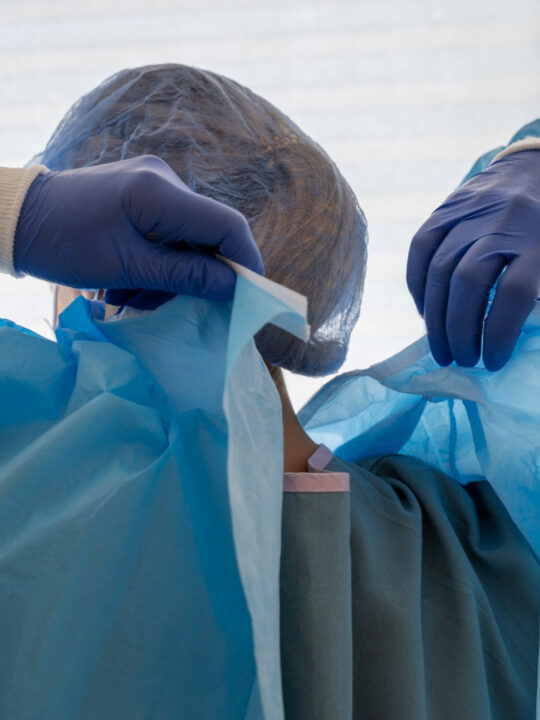 Key Takeaways:
Key Takeaways:
- Chronic migraines significantly affect quality of life, requiring more than conventional treatments.
- Alternative therapies, including behavioral and physical interventions, offer potential relief to sufferers.
- For those who suffer from migraines, staying up to date on new research and available treatments can be empowering.
Table of Contents:
- Understanding Chronic Migraine
- Traditional Treatments for Migraine
- The Emergence of Refractory Migraine
- The Role of Nutrition in Migraine Management
- Behavioral Therapies for Migraine Relief
- New Horizons: Neurostimulation Devices
- The Potential of Physical Therapy in Migraine Care
- Navigating Healthcare: Finding the Right Support for Migraine
Table of Contents
- 1 Understanding Chronic Migraine
- 2 Traditional Treatments for Migraine
- 3 The Emergence of Refractory Migraine
- 4 The Role of Nutrition in Migraine Management
- 5 Behavioral Therapies for Migraine Relief
- 6 New Horizons: Neurostimulation Devices
- 7 The Potential of Physical Therapy in Migraine Care
- 8 Navigating Healthcare: Finding the Right Support for Migraine
Understanding Chronic Migraine
It is acknowledged that chronic migraines—which are characterized as headaches that occur 15 or more days a month—represent a unique neurological condition that transcends “typical” migraines. The pain from chronic migraines is not merely discomfort; frequently characterized as a debilitating sensation, throbbing or pulsating, other symptoms like nausea, vomiting, or extreme sensitivity to stimuli often accompany it. The unpredictable nature of migraines can force individuals to alter their daily routines drastically to accommodate the incapacitating flare-ups, simultaneously creating a sense of uncertainty and apprehension about the onset of the next attack. Indeed, the debilitating nature of migraines can be so profound that even simple tasks become daunting, and opportunities for professional advancement and personal enjoyment are significantly hindered.
Effective management of chronic migraines is, therefore, a pressing concern for those affected. There are avenues in places for migraine treatment Jacksonville FL, where traditional and novel therapeutic approaches are employed to bring relief. Individuals with chronic headaches are advised to maintain a “migraine diary” in which they document the frequency, duration, and severity of their episodes, along with any possible triggers that may be aggravating their chronic condition. Identifying and understanding one’s triggers—specific foods, stress, changes in weather, or hormonal fluctuations—is a proactive step in managing the condition effectively. Moreover, educating oneself about the condition, its mechanics, triggers, and treatment options plays a pivotal role in regaining control over one’s life.
Traditional Treatments for Migraine
In the landscape of migraine treatment, traditional medicine primarily focuses on pharmaceutical interventions, such as over-the-counter pain relievers or prescription medications like triptans and antiepileptic drugs. These medications aim to alleviate symptoms during an acute migraine attack or, in some cases, act as preventive measures to reduce the frequency of attacks. Lifestyle interventions are also essential pieces of the migraine management puzzle. A comprehensive approach to managing chronic migraines can include:
- Adhering to a regular sleep schedule.
- Drinking plenty of water.
- Exercising frequently.
- Using stress-reduction methods.
However, medications are not without their drawbacks. While they can be highly effective for some, others may experience little relief. Furthermore, over-reliance on medication can sometimes result in rebound headaches, a paradoxical situation in which the very drugs meant to ease the headache pain contribute to its persistence and severity. It is where the judicious use of medication in combination with non-pharmaceutical approaches can present a more sustainable, long-term management strategy for those living with chronic migraines.
The Emergence of Refractory Migraine
For a subset of individuals, regular treatment paradigms fall short, and they find themselves grappling with what is termed “refractory migraine.” This term refers to chronic migraine that is resistant to most conventional therapies. Diagnosing a refractory migraine isn’t straightforward and typically comes only after multiple treatment failures. Healthcare professionals employ various assessments to rule out other causes and ensure a comprehensive treatment approach has been undertaken. According to estimates, the prevalence of refractory migraines ranges between 1.6% to 8% of migraine sufferers.
Patients with refractory migraines often struggle with the severity and persistence of symptoms that could culminate in regular visits to emergency departments, seeking desperate relief. These people experience severe consequences to their physical health, psychological well-being, and socioeconomic stability due to the persistent nature of their condition. In such contexts, innovative therapies outside of standard pharmacological interventions can offer a glimmer of hope.
The Role of Nutrition in Migraine Management
The complex interplay between diet and migraines is increasingly acknowledged in migraine management discourse. Certain foods and additives are well-documented as potential migraine triggers. For instance, tyramine, a naturally occurring compound found in aged cheeses and red wine, can trigger migraines in sensitive individuals. Similarly, the intake of caffeine and artificial sweeteners may also set off migraine episodes in some people. For this reason, engaging with a healthcare provider to tailor a diet that excludes known triggers can be a critical step in managing the condition.
Nutritional strategies might also involve integrating specific vitamins and minerals that have shown potential to prevent or reduce migraines’ intensity. Magnesium, for instance, is often cited for its role in neuromuscular transmission and is effective for some in reducing migraine frequency. Similarly, riboflavin (vitamin B2) has attracted attention for its potential in mitochondrial energy production, which could influence migraine pathology. It is always necessary to speak with a healthcare professional before incorporating supplements to ensure proper dosages and evaluate any possible drug interactions.
Beyond identifying triggers and integrating nutrients, the broader concept of a healthy diet is also emphasized. Embracing a comprehensive approach to dietary modification, along with suitable professional guidance, can lead to not only a reduction in migraine symptoms but also an improvement in general well-being.
Behavioral Therapies for Migraine Relief
Stress is frequently cited as a primary trigger for migraines, making stress management a cornerstone of non-pharmacological migraine therapy. Behavioral treatments like cognitive-behavioral therapy (CBT) have garnered support for their ability to help individuals reframe and manage stressors and, therefore, play a role in mitigating migraine pain. CBT encourages the development of personal coping strategies and the restructuring of negative thought patterns, which can lead to a decrease in stress-induced migraines. Additionally, mindfulness and relaxation strategies such as meditation, deep-breathing exercises, and progressive muscle relaxation are recognized for their calming effects on the nervous system. They can be leveraged as part of a holistic approach to migraine management.
Another behavioral technique that has shown potential is biofeedback, where individuals are trained to control physiological functions that are typically involuntary, such as heart rate, muscle tension, and even blood flow. By gaining awareness and control over these bodily processes, patients may feel more empowered to influence their migraine symptoms proactively. The melding of medicinal and behavioral therapies can create a robust framework that caters to both the physical and psychological dimensions of chronic migraines, enhancing the potential for effective, long-term migraine management.
New Horizons: Neurostimulation Devices
Neurostimulation represents a fascinating frontier in migraine therapy, capitalizing on technological advances to modulate the brain’s activity and alleviate migraine pain. Investigational devices that demonstrate promise in lowering the severity and frequency of migraine attacks when used as part of a treatment plan include Supraorbital Nerve Stimulation (SNS) and Transcranial Magnetic Stimulation (TMS). These devices, which can be non-invasive or minimally invasive, deliver electrical impulses or magnetic waves to some regions of the brain associated with pain transmission. The portability of some of these devices offers the convenience of self-administered treatment, providing patients with an element of control over their migraine management.
Research into the mechanisms and efficacy of neurostimulation is ongoing, with studies examining its potential as both a preventative measure and an abortive treatment for acute migraine episodes. While these devices are not universally available as part of standard migraine care, their therapeutic potential has led to heightened interest in their development for clinical use. Future developments in this field may substantially change the treatment of chronic migraines, so patients and medical professionals are advised to stay current.
The Potential of Physical Therapy in Migraine Care
Physical therapy is quite beneficial for treating several chronic conditions, including migraines. For some, musculoskeletal imbalances or postural issues contribute significantly to the development of migraine attacks. A physical therapist can provide targeted therapies to alleviate these root causes. Techniques like manual therapy, stretches, and strengthening exercises can improve posture, relieve tension, and ultimately reduce the incidence of migraines triggered by physical factors.
Physical therapists can also educate migraine sufferers on ergonomics and self-care techniques to employ at home or in the workplace, an empowerment that not only aids in immediate symptom respite but also bolsters patients’ capacity for ongoing self-management. When integrated into a comprehensive migraine care plan, physical therapy offers a complementary strategy to more conventional medical and pharmacological treatments, bringing a wealth of benefits to individuals looking for a holistic approach to address their migraine pain.
Finding the right healthcare professional who is well-versed in the complexities of migraine management can be daunting. Yet, it is a critical factor in the successful handling of this condition. Migraine specialists, often neurologists with a focus on headache medicine, are best equipped to construct multifaceted treatment plans that take into account the individualized nature of migraine. Furthermore, persistent advocacy is necessary when discussing migraine care with insurance companies, given that coverage for some therapies, especially those deemed alternative or experimental, often requires negotiation and justification.
Equally significant is the role of patient support networks and advocacy groups, which can provide emotional support and a wealth of practical information about living with and managing migraines. Through such community connections, individuals gain access to shared experiences, treatment reviews, and tips for navigating the often complex healthcare landscape. These networks remind patients that they are not alone in their struggle with migraines and provide a forum for collective knowledge-sharing and solidarity.
The journey to effective migraine management is rarely straightforward but navigable with professional medical guidance, self-education, and community support. Striking a balance between emerging therapies, lifestyle modifications, behavioral approaches, and traditional treatments is critical. Even though migraines are a chronic condition, people can still improve their quality of life by being proactive, empowered, and informed about their care.







